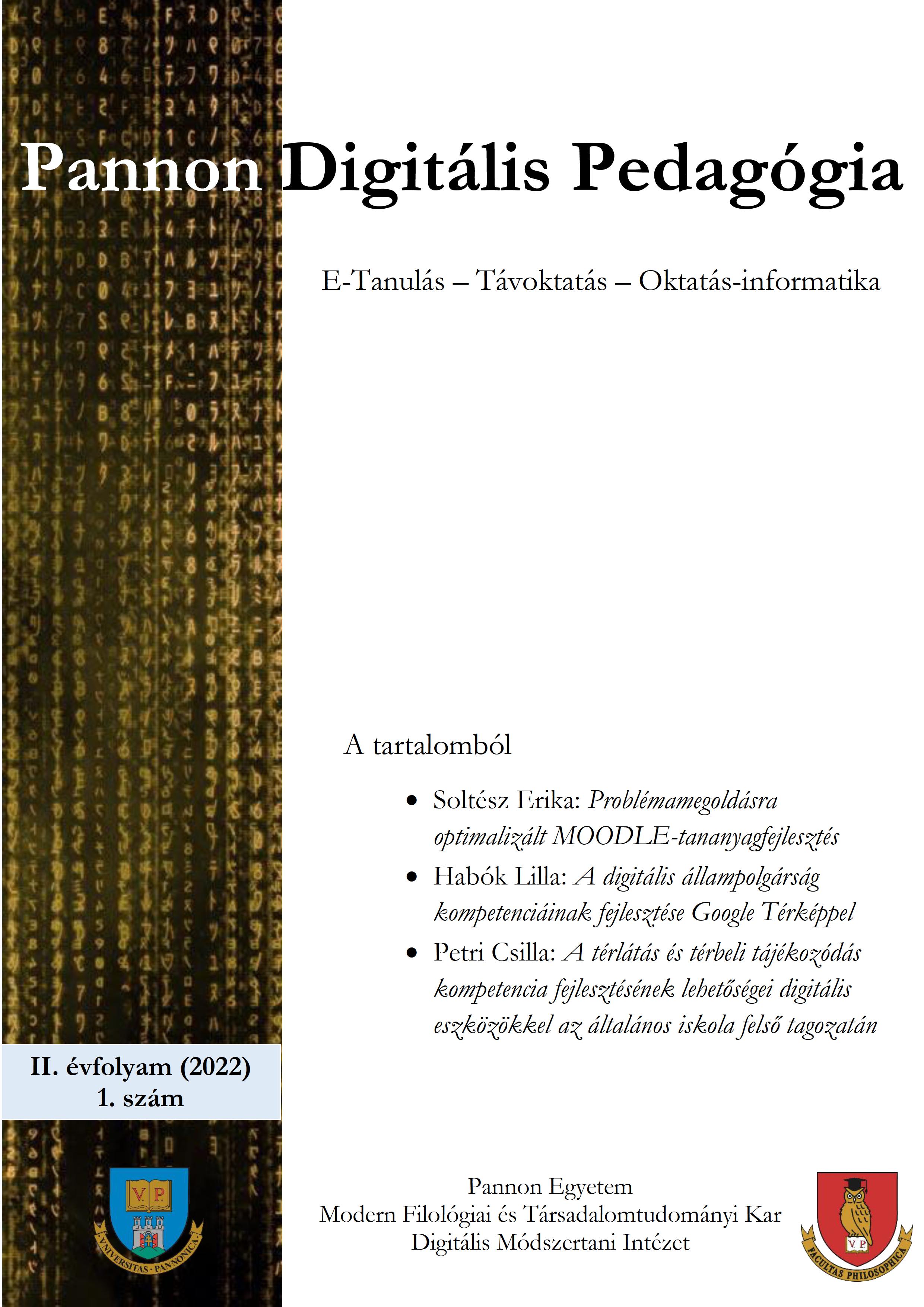A térlátás és térbeli tájékozódás kompetencia fejlesztésének lehetőségei digitális eszközökkel az általános iskola felső tagozatán
DOI:
https://doi.org/10.56665/PADIPE.2022.1.4Keywords:
spatial vision, spatial orientation, mathematical competence, digital toolsAbstract
It is a widespread conviction that women are not as good as men in terms of spatial orientation. This realization is
the basis of many jokes and debates. But is it true for everyone? And if so, what is the reason for it? Are there
biological reasons, or does our society create this difference in skills imperceptibly from a very young age Where do these differences first appear during our education? In the past decades, changes in relevant knowledge, social and economic expectations, as well as in the locations of knowledge transfer, have all proved that it is not enough to solve spatial geometry tasks on the plane of the drawing board. In fact, today, one can get much knowledge with the help of the Internet and multimedia tools that have a significantly more motivating effect on students than printed textbooks and paper-based knowledge transfer materials. With a professional background in mathematics education, the author of this paper examined spatial orientation and spatial perception skills during the solution of a spatial geometry problem listed in a high school admission form. Which competencies are required to solve the tasks perfectly?When and in how many hours is it possible to develop these competencies in our current education system? Without claiming to be exhaustive, this paper presents some digital applications that help to develop special perception skills today. The applications used in theMoodle course in the research setting were GeoGebra LearningApps, and H5P (Lumi). It was found that by incorporating them into the educational process, it is possible to make the solving of geometric tasks enjoyable and to develop the students’ mathematical competence unnoticed, and according to the results, the skill differences between boys and girls can be significantly reduced.
References
Andersen, Nicolas E. – Dahmani, Louisa – Konishi, Kyoko – Bohbot, Véronique D. (2012): Eye tracking, strategies, and sex differences in virtual navigation = Neurobiology of Learning and Memory, 97. 1. sz. 81-89. https://www.sciencedirect.com/science/article/abs/pii/S1074742711001730?via%3Dihub (utolsó hozzáférés: 2022. április 15.)
Babály Bernadett – Kárpáti Andrea (2015): A téri képességek vizsgálata papír és online tesztekkel = Magyar Pedagógia, 2. sz. 67-92. p. DOI: 10.17670/MPed.2015.2.67 https://www.edu.u-szeged.hu/mped/document/Babaly_MPed2015267.pdf (utolsó hozzáférés: 2021. december 26.)
Bánhegyesi Zoltán (2016): E-learning keretrendszerek használatának lehetősége az iskolákban. Budapest https://www.oktatas.hu/pub_bin/dload/kozoktatas/pok/Budapest/szaktanacsadoi_anyagok/informatika_lms_rendszerek.pdf
Barke, Hans-Dieter – Engida, Temechegn (2001): Structural chemistry and spatial ability in different cultures = Chemistry Education: Research and Practice in Europe, 2. 3. sz. 227–239. DOI: 10.1039/B1RP90025K https://www.researchgate.net/publication/255744217_Structural_chemistry_and_spatial_ability_in_different_cultures
Bíró Bálint (2019): Geometriai problémák és a GeoGebra = Érintő, 12. sz. https://ematlap.hu/tanora-szakkor-2019-6/870-biro-balint-geometriai-problemak-es-a-geogebra
Pintzka, Carl W.S. – Evensmoen, Hallvard R.– Lehn, Hanne – Haberg, Asta K. (2016): Changes in spatial cognition and brain activity after a single dose of testosterone in healthy women = Behavioural Brain Research, Vol. 298, Part B, 78-90. p. https://www.sciencedirect.com/science/article/pii/S0166432815302680 (utolsó hozzáférés: 2022. 07. 08.)
Ceglédy Istvánné – Hajdú Sándor – Czeglédy István: Matematika 7. Gondolkodni jó! Tanmenet https://www.muszakikiado.hu/letoltesek/kozismeret/matematika-nat-2012/go_jo_7_tanmen_2012-13/ (utolsó hozzáférés: 2021. december 26.)
Ceglédy Istvánné – dr. Hajdú Sándor – Czeglédy István: Matematika 8. Gondolkodni jó! tanmenet. https://www.muszakikiado.hu/letoltesek/kozismeret/matematika-nat-2012/go-jo_8_tanmenet_2012_/ (utolsó hozzáférés: 2021. december 26.)
Fábián Mária – Lajos Józsefné – Olasz Tamásné – Vidákovich Tibor (2008): Matematikai Kompetenciaterület. Educatio Kht. http://www.kooperativ.hu/matematika/1_koncepcio/Matematikai%20kompetencia%20fejleszt% C3%A9se.pdf (utolsó hozzáférés: 2021. december 26.)
Fazekas Gábor – Kocsis Gergely – Balla Tibor (2014): Elektronikus oktatási környezetek. Debrecen, DebreceniEgyetem, http://www.tankonyvtar.hu/hu/tartalom/tamop412A/2011- 103_10_elektronikus_oktatasi_kornyezetek/ch03s02.html
Horváthné Oroján Gabriella (2007): A Geogebra program használata a középiskolai matematika oktatásban, Budapest, ELTE Informatikai Kar Média- és Oktatásinformatikai Tanszék.
Kerber Zoltán (2006): A tantárgyközi oktatás helyzete. In. Kerber Zoltán (szerk): Hidak a tantárgyak között.
Kereszttantervi kompetenciák és tantárgyközi kapcsolatok. Budapest, Országos Közoktatási Intézet. https://ofi.oh.gov.hu/tantargykozi oktatas-helyzete (utolsóhozzáférés: 2022. február 19.)
Knausz Imre (2009): A kompetencia szerkezete és a kompetenciaalapú oktatás = Iskolakultúra 7-8. sz. 71-84. p. http://epa.oszk.hu/00000/00011/00139/pdf/2009-7-8.pdf#page=71
Ollé János – Kocsis – Ágnes – Molnár Előd – Sablik Henrik – Pápai Anna – Faragó Boglárka (2016): Oktatástervezés, digitális tartalomfejlesztés. Eger, EKF Líceum Kiadó, 102-135. p.
Papp-Varga Zsuzsanna (é. n.): GeoGebra a matematikaoktatásban. Budapest, ELTE IK. https://people.inf.elte.hu/szlavi/InfoDidact08/Manuscripts/PVZs.pdf (utolsó hozzáférés: 2022. január 30.)
Pintér Klára: Matematika tantárgy-pedagógia – „Mentor(h)áló 2.0.program” – TÁMOP-4.1.2.B.2-13/1-2013-0008 projekt 12.3. Tájékozódás http://www.jgypk.hu/mentorhalo/tananyag/Matematika_tantrgypedaggia/123_tjkozds.html (utolsó hozzáférés: 2021. március 4.)
Salat Annamária-Enikő – Séra László (2002): A téri vizualizáció fejlesztése transzformációs geometriai = Magyar Pedagógia, 4. sz. 459 473. p.
Téglási Ilona (2012): Matematikai kompetenciák megjelenése a tanulók feladatmegoldásaiban. = Módszertani közlemények. Eger. Eszterházy Károly Főiskola, Matematika Tanszék. 3. sz. http://acta.bibl.u-szeged.hu/29119/1/modszertani_052_003_000-029.pdf (utolsó hozzáférés: 2021. december 26.)
Dr. Valló Ágnes (2013): Az eltérő térérzékelés következményei. http://www.valloagnes.hu/content/view/page: eltero-tererzekeles-kovetkezmenyei/p:53-54-56?fbclid=IwAR0f2UkIMsCFek5l3CIvCXDrnAzLJBkrJ2H9SRLaLNpfY45IwDcGfkhdCCQ
Vass Vilmos (2017): A transzverzális kompetenciák tantervfejlesztési összefüggései = Autonómia és Felelősség, 3. sz. 55-65. p.
Vass Vilmos (2020): A tudásgazdagság és a 21. századi kompetenciák összefüggései = Új Munkaügyi Szemle, 1.sz. https://www.metropolitan.hu/upload/62972a5434e437a440115eace52810492fdb4273.pdf (utolsó hozzáférés: 2022. március 4.) 42
Downloads
Published
Versions
- 2023-01-17 (2)
- 2022-09-26 (1)

